To visit - Barcelona
Barcelona, the Mediterranean gem of Catalonia, is a captivating travel destination that seamlessly combines history, culture, stunning architecture, and vibrant urban life. Nestled between mountains and sea, this cosmopolitan city offers a unique experience at every turn.
The artistic soul of Barcelona shines through its iconic landmarks, starting with the Sagrada Família, Antoni Gaudí's unfinished masterpiece, whose soaring towers and exquisite details defy imagination. Park Güell, another Gaudí creation, beckons for playful exploration amidst fantastical sculptures and colorful mosaics, offering panoramic views of the city.
The historical heart of Barcelona beats within its labyrinthine Gothic Quarter, where medieval alleys reveal architectural treasures such as the Gothic cathedral and Roman remnants of the Barri Gòtic. But Barcelona isn't stuck in the past; it also breathes modernity through contemporary architectural masterpieces like the MACBA and the W Barcelona, proudly standing along the waterfront.
The bustling Ramblas, famous lively avenues, are the stage for bustling urban life, with their street vendors, buskers, and bustling cafes. Nearby, the Boqueria market bursts with Mediterranean colors and flavors, inviting visitors to sample fresh, local produce.
Catalan cuisine, rich in flavors and tradition, is best savored in picturesque tapas bars and Michelin-starred restaurants across the city. From freshly caught seafood dishes to sweet delights like churros and Catalan cream, every bite is a feast for the senses.
For a seaside getaway, Barceloneta Beach offers the perfect setting to relax under the Mediterranean sun, while culture enthusiasts can immerse themselves in the city's many museums and art galleries, where history and creativity converge.
Finally, Barcelona's festive spirit comes alive in its lively festivals, neighborhood parties, and vibrant nightlife, making every evening an adventure in itself.
Barcelona, with its cultural richness, delicious cuisine, and enchanting ambiance, promises an unforgettable travel experience where every moment is a discovery.
The 18 essential things to do in Barcelona :
Summary
- To visit
-
- 1 - Visit the Sagrada Familia
- 2 - Visit Park Güell
- 3 - Stroll along the Ramblas
- 4 - Explore the Gothic Quarter
- 5 - Climb to the top of Montjuïc
- 6 - Enjoying the beach in Barceloneta
- 7 - The museums of Barcelona
- 8 - Le quartier de Gràcia
- 9 - Visit the Camp Nou stadium
- 10 - Casa Batlló and Casa Milà (La Pedrera)
- 11 - Tibidabo mountain
- 12 - The city's Arab baths
- 13 - The Boqueria market
- 14 - Ciutadella Park
- 15 - Attend a flamenco show
- 16 - Nightlife in Barcelona
- 17 - Taste Catalan cuisine
- 18 - Take a day trip to Montserrat
- Barcelona - Where to Stay?
- Barcelona - How to get around?
- Barcelona - Best period
1 - Visit the Sagrada Familia
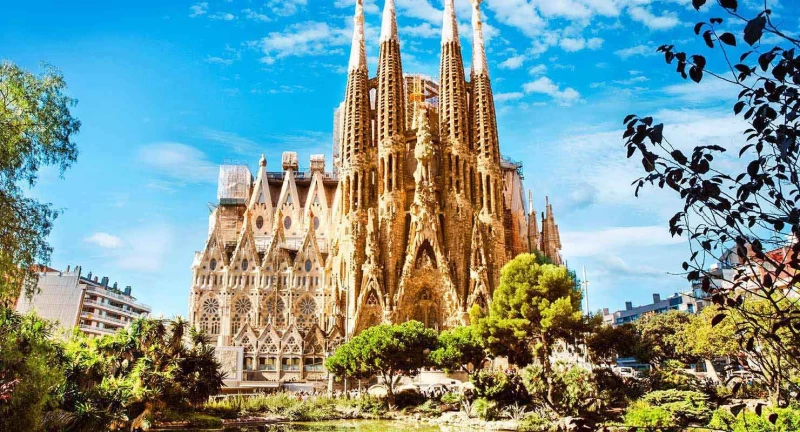
Embark on a journey to discover one of Spain's most iconic architectural wonders: the Sagrada Familia in Barcelona. Towering and majestic, this basilica, unlike any other in the world, transports you to a realm of beauty and spirituality.
Upon arrival, marvel at the intricate details of its façade adorned with sculptures depicting biblical scenes. The soaring towers rise towards the sky, beckoning you to explore the incredible harmony between Gothic art and the boldness of modernist architecture.
As you step inside, you'll be enveloped in a sacred atmosphere, bathed in colorful light filtering through the stained glass windows. The columns rise like heavenly trees, supporting a celestial ceiling adorned with intricate motifs.
Every corner of this basilica tells a story, every detail the result of a unique creative vision. Walk through the aisles and let yourself be captivated by the grandeur and magic of this extraordinary place, where art and faith converge in an unforgettable visual symphony.
The Sagrada Familia is more than just a monument. It's an invitation to a spiritual and aesthetic journey, where the soul is nourished by beauty and transcendence. Don't miss this unforgettable experience on your next trip to Barcelona.
 Our tips for getting the most out of your experience.
Our tips for getting the most out of your experience.
If you're planning to visit the Sagrada Familia during your trip to Barcelona, here are some tips to make your experience more enjoyable and enriching:
-
Book your tickets in advance: The Sagrada Familia is a very popular attraction, and the lines can be long. Book your tickets online in advance to avoid queues and ensure entry at your desired time.
-
Consider a guided tour: For a better understanding of the history, architecture, and details of the Sagrada Familia, consider booking a guided tour. Guides can provide valuable insights and allow you to discover aspects of the basilica you might otherwise miss.
-
Allow plenty of time: The Sagrada Familia is huge, and there's much to see inside. Plan to spend at least one to two hours exploring the basilica and its surroundings at your leisure.
-
Visit early morning or late afternoon: To avoid crowds, consider visiting the Sagrada Familia early in the morning or late in the afternoon. Early morning and late afternoon hours are typically less crowded than midday.
-
Climb the towers: If you're not afraid of heights, don't miss the opportunity to climb one of the towers of the Sagrada Familia. You'll be rewarded with a spectacular view of Barcelona from the top.
-
Respect the dress code: As it's a place of worship, make sure to respect the appropriate dress code. Avoid clothing that's too short, shoulders uncovered, and hats inside the basilica.
-
Take time to soak in the atmosphere: The Sagrada Familia is not only an architectural masterpiece but also a place of spirituality and contemplation. Take the time to sit, soak in the atmosphere, and appreciate the beauty surrounding you.
By following these tips, you'll be able to fully enjoy your visit to the Sagrada Familia and make it an unforgettable experience.
2 - Visit Park Güell
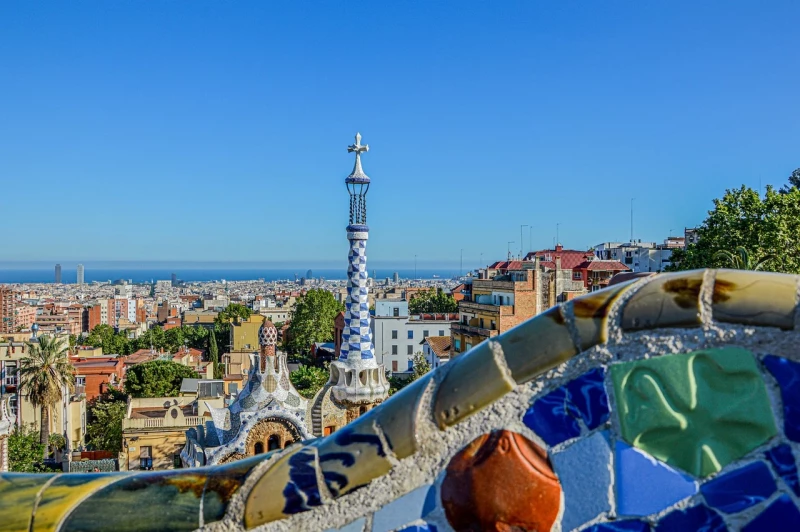
Embark on a journey through the enchanting world of Park Güell during your visit to Barcelona, Spain. Designed by the Catalan architect Antoni Gaudí, this iconic park is a masterpiece of art and architecture that transports you to a realm of colors, organic shapes, and dreams.
As you arrive, be amazed by the famous entrance of the park, flanked by two pavilions guarded by colorful dragons. You'll immediately immerse yourself in Gaudí's fantastical universe, where every corner reveals a new wonder.
Stroll along the winding pathways of the park, lined with leaning columns and vibrant mosaics, and admire panoramic views of the city of Barcelona from the spectacular terraces. You'll be surrounded by lush nature and surprising details that adorn the landscape, from wave-shaped benches to fountains adorned with colorful ceramics.
Don't miss the iconic Hypostyle Room, with its columns shaped like tree trunks, or Gaudí's house-museum, where you can learn more about the life and work of the visionary architect.
Whether you're watching the sunset from one of the terraces or getting lost in the park's maze-like pathways, a visit to Park Güell is an unforgettable experience that awakens the senses and fuels the imagination. It's a place where art, nature, and fantasy come together to create a true paradise on earth.
 Our tips for getting the most out of your experience.
Our tips for getting the most out of your experience.
If you're planning to visit Park Güell during your trip to Barcelona, here are some tips to enhance your experience:
-
Book tickets in advance: Similar to other popular attractions in Barcelona, Park Güell can get crowded, especially during peak tourist seasons. Booking your tickets online in advance will save you time and ensure you can enter the park at your preferred time slot.
-
Visit early in the day or late in the afternoon: To avoid the crowds and the heat, consider visiting the park early in the morning or later in the afternoon. This will not only give you a more peaceful experience but also provide better lighting for photography.
-
Wear comfortable shoes: Park Güell is quite extensive and features many pathways with uneven terrain. Comfortable walking shoes are recommended to explore the park comfortably.
-
Bring water and snacks: While there are facilities within the park, including cafes, bringing your own water and snacks can be convenient, especially if you plan on spending a few hours exploring the area.
-
Explore beyond the main areas: While the monumental zone, with its famous structures and viewpoints, is undoubtedly the highlight of Park Güell, don't forget to venture into the surrounding natural areas. You'll find quieter spots and beautiful views of Barcelona.
-
Respect the rules and surroundings: Park Güell is a UNESCO World Heritage Site, and it's essential to respect the rules and regulations in place to preserve its beauty. This includes staying on designated pathways, not climbing on the structures, and disposing of trash properly.
-
Consider a guided tour: Joining a guided tour can provide valuable insights into the history, architecture, and significance of Park Güell. Guides can offer interesting facts and stories that you might not discover on your own.
By following these tips, you'll be able to make the most of your visit to Park Güell and fully appreciate its beauty and charm. Enjoy your time exploring this iconic landmark in Barcelona!
3 - Stroll along the Ramblas
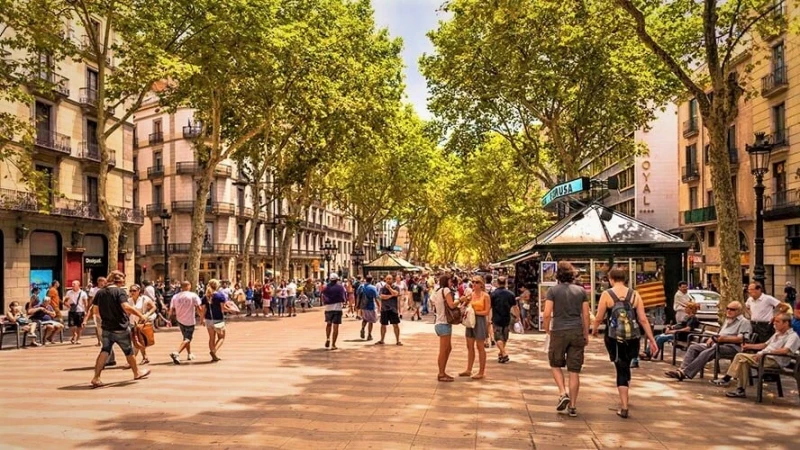
The Rambla, or La Rambla de Barcelona, is a famous promenade located in the heart of the city of Barcelona, Spain. It stretches for about 1.2 kilometers, connecting the Plaça de Catalunya to the old port of the city.
The lively atmosphere of La Rambla makes it one of Barcelona's most iconic attractions, drawing millions of visitors each year.
-
Vibrant Atmosphere: La Rambla is renowned for its lively and cosmopolitan atmosphere. Street artists, musicians, dancers, painters, and jugglers add to the colorful and joyful ambiance.
-
Tree-Lined Boulevard: Lined with majestic trees, La Rambla offers a pleasant shaded walkway, perfect for strolling and people-watching.
-
Markets and Stalls: Along La Rambla, you'll find a variety of outdoor markets, flower stalls, souvenir stands, and small shops selling local products, souvenirs, and crafts.
-
Impressive Architecture: Throughout La Rambla, you'll encounter historic buildings, theaters, and elegant hotels, some dating back several centuries.
-
Font de Canaletes: One of the most famous landmarks on La Rambla is the Font de Canaletes, a popular gathering spot for football fans, where it is said that drinking water from the fountain guarantees a return to Barcelona.
-
La Boqueria: La Boqueria market, located along La Rambla, is a must-visit for food enthusiasts. With its colorful stalls overflowing with fresh fruits, seafood, charcuterie, cheeses, and more, it's a feast for the senses.
-
Theaters and Cinemas: La Rambla is also known for its historic theaters and cinemas, offering a variety of shows and films to entertain visitors.
-
Christopher Columbus Statue: At the lower end of La Rambla, near the port, stands the iconic statue of Christopher Columbus, another significant landmark of the city.
In summary, La Rambla de Barcelona is more than just an avenue; it's a symbol of Barcelona's vibrant and cosmopolitan soul, where history, culture, gastronomy, and entertainment converge to offer an unforgettable experience to travelers.
 Our tips for getting the most out of your experience.
Our tips for getting the most out of your experience.
Walking along the Ramblas can be a delightful experience, but there are a few tips to keep in mind to fully enjoy it:
-
Choose the Right Time: The Ramblas can get very crowded, especially during peak hours and holidays. Try to plan your walk early in the morning or in the evening to avoid the crowds.
-
Stay Vigilant: Like in any major tourist city, it's important to remain vigilant against pickpockets. Keep an eye on your belongings, such as your purse or wallet, and avoid ostentatiously displaying valuable items.
-
Explore Adjacent Streets: The Ramblas is lined with many charming side streets that are worth exploring. Don't hesitate to venture into the adjacent streets to discover quaint shops, quiet cafes, and authentic local atmosphere.
-
Relax in Cafes: There are plenty of cafes along the Ramblas where you can sit down, have a coffee or refreshment, and people-watch. It's a great way to enjoy the lively atmosphere while taking a break.
-
Taste Local Specialties: Don't miss the opportunity to sample the culinary delights offered along the Ramblas, including tapas, fresh seafood, and fresh fruit juices from local markets.
-
Take Your Time: Don't feel rushed to cover the entire length of the Ramblas in one go. Take your time to admire the architecture, watch street performers, and soak in the unique atmosphere of this iconic location.
-
Use Public Transportation: If you don't want to walk the entire length of the Ramblas, you can use public transportation, such as the metro or buses, to easily get around the city.
By following these tips, you can fully enjoy your walk along the Ramblas in Barcelona and make it a memorable experience.
4 - Explore the Gothic Quarter
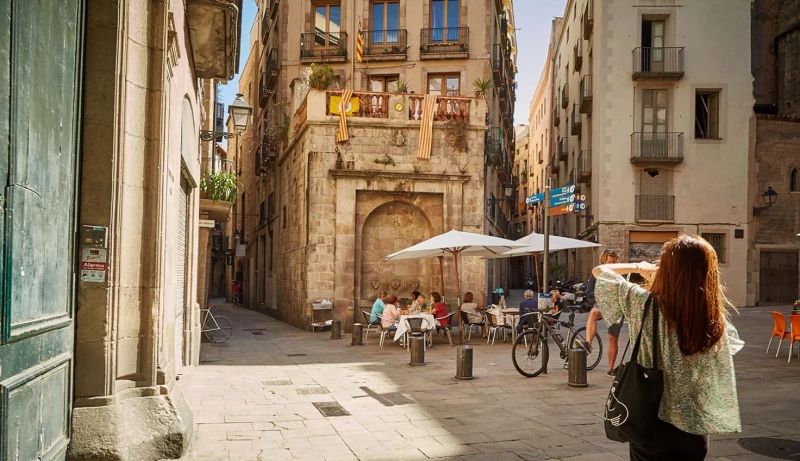
The Gothic Quarter, or Barri Gòtic, is one of the most captivating and historic neighborhoods in Barcelona, Spain. Here's a description of this enchanting district:
-
Medieval Streets: The Gothic Quarter is a labyrinth of narrow, winding streets dating back to the Middle Ages. As you wander through its alleys, you'll encounter picturesque squares, hidden courtyards, and centuries-old buildings adorned with intricate facades.
-
Architectural Marvels: The neighborhood is home to some of Barcelona's most iconic landmarks, including the stunning Barcelona Cathedral (Catedral de Barcelona) with its magnificent Gothic architecture and the Plaça del Rei, a medieval square surrounded by historic buildings such as the Palau Reial Major and the Palau del Lloctinent.
-
Cultural Heritage: The Gothic Quarter is steeped in history and culture, with archaeological sites like the Roman Temple of Augustus (Temple d'August) and remnants of the ancient Roman city of Barcino scattered throughout the area. Visitors can also explore the Museu d'Història de Barcelona (Barcelona City History Museum) to learn more about the neighborhood's rich past.
-
Artistic Vibes: The Gothic Quarter has long been a hub for artists and bohemians, with numerous art galleries, boutiques, and artisan workshops tucked away in its maze of streets. Visitors can admire local artwork, handmade crafts, and unique souvenirs while soaking up the neighborhood's creative energy.
-
Culinary Delights: The Gothic Quarter is home to a diverse array of eateries, from traditional Catalan taverns serving authentic tapas to trendy cafes and gourmet restaurants. Whether you're craving classic Spanish dishes or international cuisine, you'll find plenty of dining options to satisfy your palate.
-
Vibrant Atmosphere: Day or night, the Gothic Quarter buzzes with activity, from bustling markets and lively street performers to vibrant nightlife venues and cozy bars. Whether you're exploring its historic landmarks, shopping for local treasures, or simply soaking up the ambiance, there's always something new to discover in this dynamic neighborhood.
-
Charming Plazas: The Gothic Quarter is dotted with charming squares (plazas) where locals and visitors alike gather to relax, socialize, and enjoy the vibrant street life. From the lively Plaça Reial with its palm trees and iconic lampposts to the tranquil Plaça Sant Felip Neri with its hauntingly beautiful architecture, each square has its own unique charm.
Overall, the Gothic Quarter of Barcelona is a captivating blend of history, culture, art, and gastronomy, offering visitors a truly immersive experience in the heart of one of Europe's most enchanting cities.
 Our tips for getting the most out of your experience.
Our tips for getting the most out of your experience.
Exploring the Gothic Quarter of Barcelona can be a fascinating experience. Here are some tips to make the most of it:
-
Get Lost in the Alleyways: One of the best ways to discover the Gothic Quarter is to let your curiosity guide you and get lost in its narrow streets. This is where you'll find hidden gems, quaint shops, and quiet corners.
-
Take Your Time: There's no better way to explore the Gothic Quarter than by walking at a leisurely pace. Take the time to admire the architecture, stroll through the squares, and soak up the unique atmosphere of this historic neighborhood.
-
Visit Historic Sites: Don't miss the main historical sites of the Gothic Quarter, such as the Barcelona Cathedral, the City History Museum, and the remnants of the ancient Roman city of Barcino. These sites offer fascinating insights into the area's history.
-
Explore Shops and Artisans: The Gothic Quarter is full of craft shops, art galleries, and unique stores where you can find original souvenirs and local artwork. Don't hesitate to explore these places to discover hidden treasures.
-
Enjoy Local Gastronomy: Take a break at one of the many taverns and restaurants in the Gothic Quarter to enjoy authentic tapas, traditional Catalan dishes, or international delights. It's a great opportunity to taste local cuisine and try new dishes.
-
Immerse Yourself in the Nighttime Atmosphere: The Gothic Quarter takes on a whole new dimension after dark, when the streets come alive with the lights of cafes, bars, and clubs. Explore the illuminated alleyways by lamplight and soak up the neighborhood's magical atmosphere.
-
Stay Aware of Safety: Like in any major tourist city, it's important to stay vigilant against pickpockets and take care of your personal belongings, especially in crowded areas.
By following these tips, you'll be able to fully enjoy your exploration of Barcelona's Gothic Quarter and discover everything it has to offer in terms of history, culture, and authentic charm.
5 - Climb to the top of Montjuïc
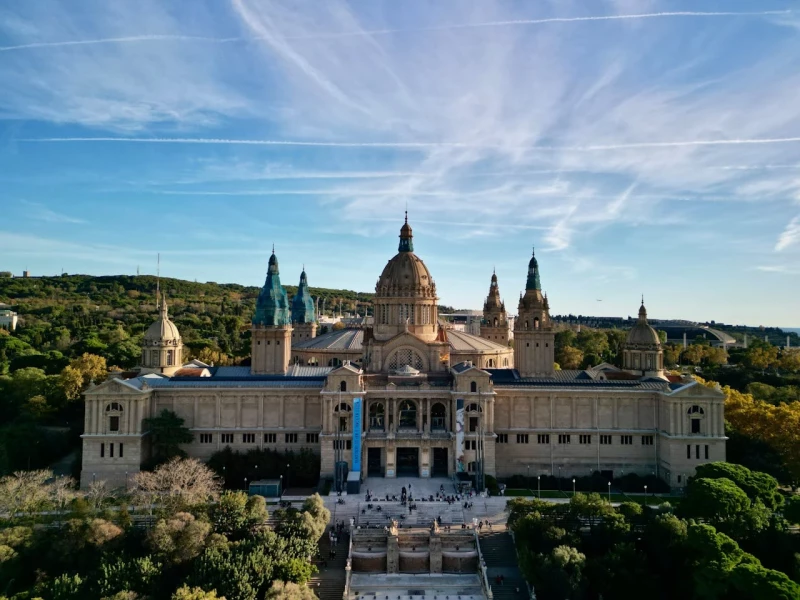
Montjuïc is a prominent hill overlooking Barcelona, Spain, offering a rich tapestry of cultural, historical, and natural attractions. Here's a description of Montjuïc for a travel theme:
-
Panoramic Views: Montjuïc provides stunning panoramic views of Barcelona and its coastline. Visitors can enjoy breathtaking vistas of the city, the Mediterranean Sea, and the surrounding mountains from various vantage points on the hill.
-
Cultural Landmarks: Montjuïc is home to a wealth of cultural landmarks, including the Montjuïc Castle, a historic fortress dating back to the 17th century, which offers insight into the city's military history and stunning views. Additionally, the Museu Nacional d'Art de Catalunya (MNAC) showcases an extensive collection of Catalan art spanning different periods, from Romanesque to Modernism.
-
Olympic Legacy: Montjuïc was a focal point during the 1992 Summer Olympics, hosting several events and leaving a lasting Olympic legacy. The Olympic Stadium, designed by renowned architect Santiago Calatrava, and the Palau Sant Jordi, a versatile indoor arena, stand as reminders of this monumental event.
-
Gardens and Parks: The hill of Montjuïc is adorned with beautiful gardens and parks, offering tranquil retreats amidst the bustling city. The Montjuïc Botanical Garden boasts a diverse collection of Mediterranean flora, while the Jardins de Joan Brossa provides lush green spaces and panoramic views.
-
Cable Car Ride: Visitors can ascend Montjuïc via a scenic cable car ride, offering a bird's-eye view of the city and the sea. The journey provides a unique perspective of Barcelona's iconic landmarks and the natural beauty of Montjuïc.
-
Cultural Events and Festivals: Montjuïc hosts various cultural events and festivals throughout the year, including music concerts, outdoor film screenings, and art exhibitions. These events showcase the vibrant cultural scene of Barcelona and attract locals and tourists alike.
-
Outdoor Activities: Montjuïc offers ample opportunities for outdoor activities, such as hiking, cycling, and picnicking. The hill's network of trails and paths allows visitors to explore its natural landscapes and discover hidden gems along the way.
Overall, Montjuïc serves as a multifaceted destination that appeals to history buffs, art enthusiasts, nature lovers, and adventure seekers alike, making it a must-visit for anyone exploring Barcelona.
 Our tips for getting the most out of your experience.
Our tips for getting the most out of your experience.
To ascend to the top of Montjuïc and fully enjoy this experience, here are some useful tips:
-
Take the Cable Car or Funicular: Riding the cable car or funicular is a great way to ascend to the summit of Montjuïc while enjoying spectacular panoramic views of Barcelona. Be sure to check the operating hours and fares before your visit.
-
Hike or Bike: For the more adventurous, hiking or biking to the top of Montjuïc is an option. There are several trails and bike paths that wind through the hill, offering a closer-to-nature experience.
-
Plan Your Visit: Before ascending to the top of Montjuïc, take the time to plan your visit. Check the opening hours of attractions, special events, and points of interest you want to explore once you're up there.
-
Protect Yourself from the Sun: Montjuïc can be exposed to the sun, especially during the summer months. Make sure to wear a hat, sunglasses, and sunscreen to protect yourself from UV rays, especially if you plan to spend time outdoors.
-
Bring Water and Snacks: It's always a good idea to bring water and snacks when ascending to the top of Montjuïc, especially if you plan on hiking or extended exploration. This will keep you hydrated and energized throughout your visit.
-
Enjoy the Views: Once at the top of Montjuïc, take the time to enjoy the spectacular views of Barcelona and its surroundings. Take photos, breathe in the fresh air, and soak in the natural beauty of the hill.
-
Explore the Attractions: Montjuïc offers a variety of attractions and landmarks to explore, including Montjuïc Castle, the Joan Miró Foundation, and the Olympic Stadium. Take your time to discover these sites and learn about the history and culture of the area.
By following these tips, you'll be able to ascend to the top of Montjuïc with ease and fully enjoy this unforgettable experience in Barcelona.
6 - Enjoying the beach in Barceloneta
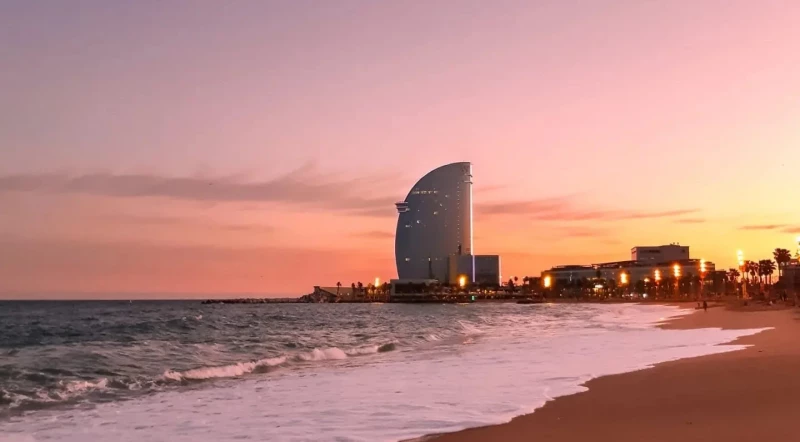
The Barceloneta Beach is one of the most popular beaches in Barcelona, Spain. Located in the Barceloneta neighborhood, this urban beach stretches for about a kilometer along the Mediterranean coast. The beach attracts a large number of both locals and tourists due to its proximity to the city center and its modern facilities.
The beach offers a range of amenities and activities, including volleyball courts, outdoor fitness equipment, beach soccer fields, as well as bars and restaurants along the promenade. It's a popular spot for relaxing, sunbathing, swimming, and participating in various water sports.
Barceloneta Beach is also well-connected to the rest of the city via public transportation, making it easily accessible for residents and visitors alike. However, due to its popularity, it can get very crowded during the summer months, especially on weekends.
 Our tips for getting the most out of your experience.
Our tips for getting the most out of your experience.
Here are some tips for enjoying Barceloneta Beach:
-
Arrive Early: During peak tourist season, Barceloneta Beach can get quite crowded. Arriving early in the morning allows you to secure a good spot on the sand and enjoy a quieter atmosphere.
-
Bring Essentials: Don't forget to pack sunscreen, sunglasses, a hat, and plenty of water to stay hydrated under the Mediterranean sun. Also, bring a towel or a beach mat for lounging comfortably.
-
Stay Safe: Keep an eye on your belongings, especially valuables, as pickpocketing can occur in crowded areas. Additionally, pay attention to warning flags indicating sea conditions and swim within designated safe areas.
-
Explore the Promenade: Take a stroll along the lively promenade that runs parallel to the beach. You'll find a variety of bars, cafes, and restaurants offering refreshing drinks and tasty snacks.
-
Try Water Sports: Barceloneta Beach offers opportunities for water sports such as paddleboarding, windsurfing, and jet skiing. Rental shops along the beach provide equipment and instruction if needed.
-
Enjoy the Sunset: Stick around until the evening to witness breathtaking sunsets over the Mediterranean Sea. The beach takes on a different ambiance as the day transitions into night, with the city lights providing a magical backdrop.
-
Sample Local Cuisine: After a day at the beach, indulge in some delicious seafood at one of the many restaurants in the Barceloneta neighborhood. Traditional paella and fresh seafood dishes are local favorites.
-
Use Public Transportation: Barceloneta Beach is easily accessible by public transportation, including buses and the metro. Avoid the hassle of finding parking by utilizing the efficient public transit system.
By following these tips, you can make the most of your time at Barceloneta Beach and create unforgettable memories in one of Barcelona's most iconic locations.
7 - The museums of Barcelona
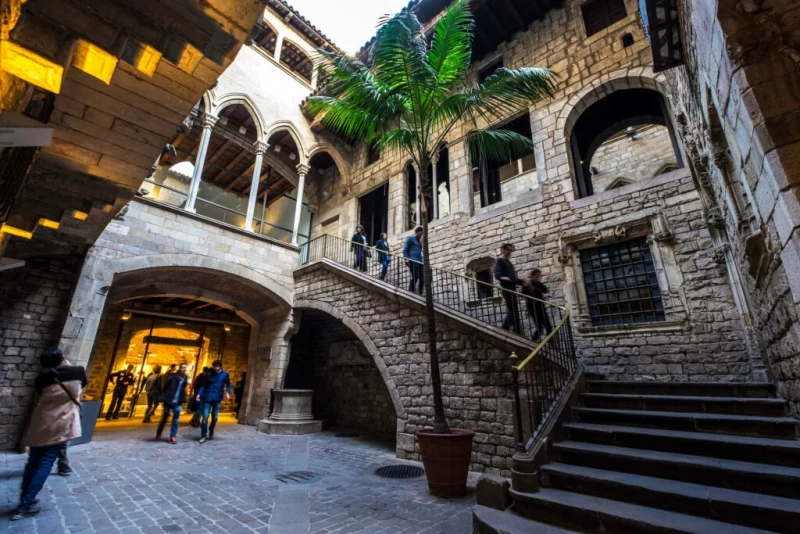
Barcelona is a city rich in culture and history, and it's home to several interesting museums that offer fascinating insights into various aspects of art, history, and society. Here are some of Barcelona's most popular museums:
-
Picasso Museum: Located in the Born district, this museum houses one of the most important collections of Pablo Picasso's early works. You can see paintings, drawings, and ceramics that illustrate the evolution of his artistic style.
-
MNAC (National Art Museum of Catalonia): Housed in the magnificent Palau Nacional on Montjuïc hill, MNAC features an extensive collection of Catalan art spanning from the Middle Ages to the early 20th century. Highlights include Romanesque paintings, Gothic sculptures, Baroque frescoes, and Modernist works.
-
Joan Miró Foundation: Dedicated to one of Barcelona's most famous artists, this museum showcases an impressive collection of Joan Miró's works, ranging from paintings and sculptures to drawings and textiles. It's located on Montjuïc hill, offering stunning views of the city.
-
Barcelona City History Museum (MUHBA): This museum offers a captivating journey through Barcelona's history, from Roman times to the Middle Ages. It includes several archaeological sites scattered throughout the city, including Roman ruins beneath Plaça del Rei and medieval remnants in the Gothic Quarter.
-
MACBA (Barcelona Museum of Contemporary Art): Located in the Raval district, MACBA is dedicated to contemporary art, featuring both permanent and temporary exhibitions showcasing works by national and international artists.
-
Barcelona Museum of Music: This museum, situated in the La Ribera neighborhood, houses a vast collection of musical instruments from around the world, as well as exhibitions on the history of music in Barcelona.
-
Jewish History Museum of Barcelona (Call de Barcelona): This museum provides a fascinating glimpse into Barcelona's rich Jewish history, with exhibitions on the daily life, culture, and religion of Jewish communities that lived in the city over the centuries.
These museums are just a sampling of Barcelona's rich cultural scene, and there are many other museums and art galleries to discover throughout the city.
 Our tips for getting the most out of your experience.
Our tips for getting the most out of your experience.
Visiting the museums of Barcelona can be a rewarding experience. Here are some tips to make the most of your visit:
-
Plan Ahead: Check the opening hours, weekly closing days, and admission fees of the museums you plan to visit. Some museums offer discounts for students, seniors, or local residents.
-
Buy Tickets in Advance: Whenever possible, purchase your tickets online in advance to avoid queues at the ticket counters. This can save you time and allow you to enjoy more of your visit.
-
Plan Your Itinerary: If you have multiple museums to visit, organize your itinerary based on their geographic proximity. This will help you optimize your time and minimize travel between sites.
-
Allocate Enough Time: Allow yourself enough time to explore each museum at your own pace. Some exhibitions can be extensive and may require several hours to fully appreciate.
-
Use Audio Guides or Guided Tours: Many museums offer audio guides or guided tours that provide additional information about the artworks and exhibitions. This can enrich your experience and allow you to learn more about the collections.
-
Respect Museum Rules: Be sure to adhere to the museum rules, such as the prohibition of photography in certain rooms or touching the artworks. This ensures the preservation of the collections for future generations.
-
Take Advantage of Museum Facilities: Many museums have cafes, gift shops, and gardens where you can relax and unwind after your visit. Take the opportunity to enjoy a coffee or purchase unique souvenirs.
By following these tips, you'll be able to fully enjoy your visit to the museums of Barcelona and discover everything the city has to offer in terms of art, history, and culture.
8 - Le quartier de Gràcia
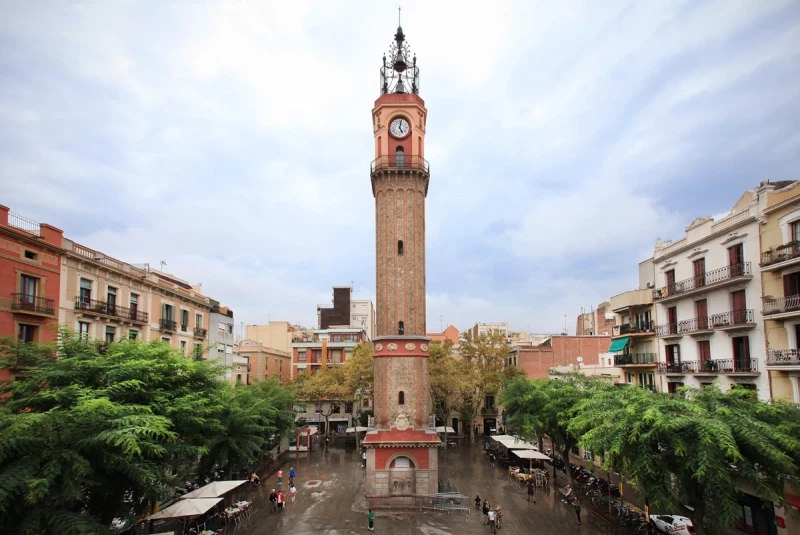
Gràcia is one of the most charming and eclectic neighborhoods in Barcelona. Here are some highlights and characteristics of this area:
-
Bohemian and alternative atmosphere: Gràcia has maintained a bohemian and alternative atmosphere, with its narrow winding streets, picturesque squares, and colorful buildings. The neighborhood is known for its artistic spirit and friendly vibe.
-
Neighborhood festivals: Every year in August, Gràcia celebrates its famous neighborhood festivals, where the streets are extravagantly decorated by residents and neighborhood associations. These festivities include outdoor concerts, traditional dances, parades, and much more.
-
Cafes and terraces: Gràcia is full of quaint cafes, bars, and terraces where you can relax and enjoy the lively atmosphere of the neighborhood. It's the perfect place to sip coffee on a terrace while people-watching.
-
Local markets: The neighborhood is home to several local markets where you can buy fresh produce, fruits, vegetables, artisanal products, and more. The Abaceria Central Market and the Llibertat Market are among the most popular.
-
Architecture: Gràcia boasts a great architectural diversity, with modernist buildings, traditional houses, and colorful facades. Don't miss strolling through the streets to admire the varied architecture of the neighborhood.
-
Cinemas and theaters: The area is home to several independent cinemas and theaters that offer a diverse program of films, plays, and live performances.
-
Parks and green spaces: Gràcia also provides easy access to several parks and green spaces, such as Park Güell, where you can take a stroll, engage in sports, or simply relax outdoors.
In summary, Gràcia is a lively and dynamic neighborhood that is definitely worth exploring when visiting Barcelona, whether for its festivals, relaxed atmosphere, or cultural richness.
9 - Visit the Camp Nou stadium
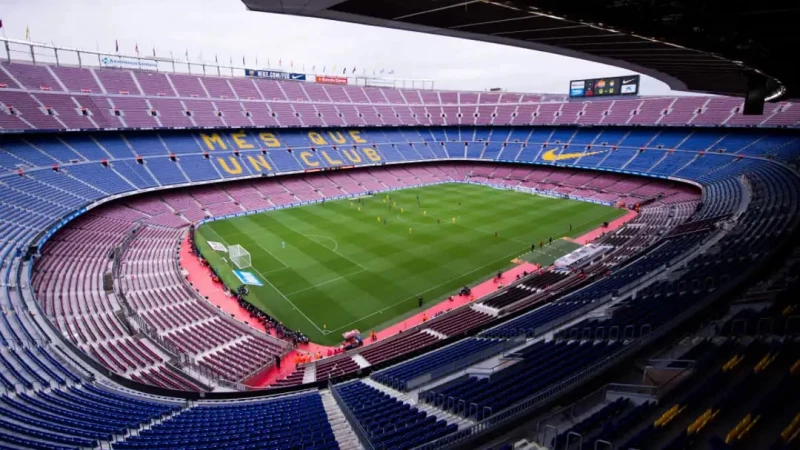
If you're a football enthusiast or simply interested in experiencing one of the most iconic sporting venues in the world, a visit to Camp Nou, the home stadium of FC Barcelona, is an absolute must when traveling to Barcelona. Here's why Camp Nou could be a fascinating theme for your travel itinerary:
-
Immersive Football Experience: Camp Nou offers visitors the chance to immerse themselves in the world of football like never before. From the moment you step into the stadium, you can feel the electric atmosphere and passion for the game that permeates every corner of this legendary venue.
-
Stadium Tour: Explore the iconic stadium with a guided tour that takes you behind the scenes. Walk through the player's tunnel, visit the locker rooms, step onto the pitch, and imagine yourself playing in front of thousands of cheering fans. You'll also have the opportunity to visit the FC Barcelona Museum, where you can learn about the club's rich history, see trophies and memorabilia, and even test your skills in interactive exhibits.
-
Matchday Experience: If you're lucky enough to visit during a matchday, attending a game at Camp Nou is an unforgettable experience. Feel the excitement as the crowd roars, watch some of the world's best players in action, and soak up the vibrant atmosphere of one of football's most iconic stadiums.
-
Iconic Landmark: Camp Nou is not just a stadium; it's a symbol of Barcelona and Catalan identity. As one of the largest stadiums in Europe, it has hosted countless memorable moments in football history and has become an essential part of the city's cultural fabric.
-
Surrounding Area: Located in the Les Corts district of Barcelona, Camp Nou is surrounded by a lively neighborhood with plenty of restaurants, bars, and shops. After your stadium visit, take some time to explore the area and immerse yourself in the local culture.
Whether you're a die-hard football fan or simply curious to experience the magic of Camp Nou, a visit to this iconic stadium is sure to be a highlight of your trip to Barcelona.
 Our tips for getting the most out of your experience.
Our tips for getting the most out of your experience.
If you're planning to visit Camp Nou stadium during your stay in Barcelona, here are some tips to ensure you have an optimal experience:
-
Book your tickets in advance: Tours of Camp Nou can be highly popular, especially during peak tourist seasons. It's advisable to book your tickets in advance, preferably online, to avoid long queues at the ticket counters.
-
Opt for a guided tour: A guided tour of Camp Nou will provide you with a comprehensive insight into the stadium and its behind-the-scenes areas. Guides are often passionate football enthusiasts who share interesting anecdotes and historical information about the stadium and the club.
-
Arrive early: If you've booked a guided tour, make sure to arrive at the designated time on your ticket. This will allow you to fully enjoy your tour without feeling rushed.
-
Wear comfortable clothing and appropriate footwear: Visiting Camp Nou may involve a lot of walking, especially through the stands and corridors of the stadium. Make sure to wear comfortable clothing and shoes suitable for walking.
-
Bring a water bottle and snacks: It can get hot during the stadium tour, especially in the summer, so remember to bring a water bottle to stay hydrated. You can also pack some snacks to munch on during the tour if needed.
-
Take photos, but respect the rules: You'll likely want to take souvenir photos during your visit. Make sure to respect the stadium's rules regarding photography, avoiding taking photos where it's prohibited.
-
Visit the FC Barcelona Museum: A tour of Camp Nou typically includes access to the FC Barcelona Museum, where you can explore the club's history, see trophies and iconic jerseys, as well as interactive exhibitions.
By following these tips, you'll be well-prepared to fully enjoy your visit to Camp Nou stadium and discover all the fascinating aspects of this renowned football venue.
10 - Casa Batlló and Casa Milà (La Pedrera)
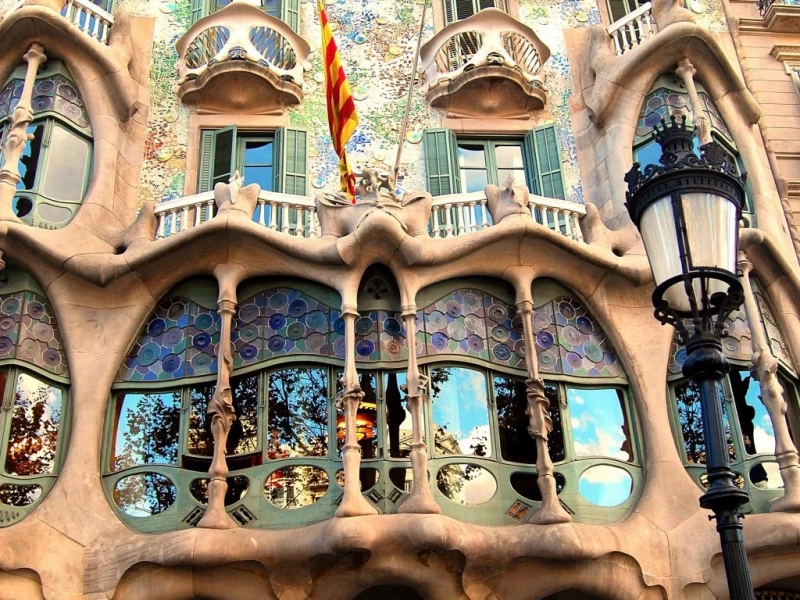
La Casa Batlló and Casa Milà, both located in Barcelona, are two of the most iconic architectural works by the renowned Catalan architect Antoni Gaudí. Here's an overview of each of these magnificent structures:
-
Casa Batlló:
- Located on Passeig de Gràcia, Casa Batlló is a masterpiece of Catalan modernism designed by Antoni Gaudí. It was built between 1904 and 1906 for the wealthy industrialist Josep Batlló.
- Casa Batlló's exterior facade is famous for its organic design and undulating forms, which evoke a rippling sea. It is covered with colorful ceramic tiles and stone sculptures.
- The interior of Casa Batlló is equally impressive, featuring fantastic decorative elements, colorful mosaics, and meticulous attention to detail. A visit to the interior allows visitors to discover Gaudí's innovative works and understand his unique design process.
-
Casa Milà (La Pedrera):
- Also situated on Passeig de Gràcia, Casa Milà, also known as La Pedrera, is another major work by Gaudí completed in 1912. It was commissioned by Pere Milà and his wife Roser Segimon.
- Casa Milà is distinguished by its undulating limestone facade, which appears to evoke waves. Unlike Casa Batlló, Casa Milà presents a more austere and monumental appearance.
- The interior of Casa Milà is also remarkable, with interior courtyards adorned with wrought iron sculptures, winding passages, and apartments designed with a particular focus on natural light and ventilation.
Both Casa Batlló and Casa Milà are open to the public for guided tours that allow visitors to admire their exceptional architecture and learn more about Gaudí's work. These two buildings are must-visit destinations for architecture enthusiasts and visitors interested in the history and culture of Barcelona.
 Our tips for getting the most out of your experience.
Our tips for getting the most out of your experience.
If you're planning to visit Casa Batlló and Casa Milà during your trip to Barcelona, here are some tips to enhance your experience:
-
Book Tickets Online in Advance: Both Casa Batlló and Casa Milà can get crowded, especially during peak tourist seasons. To avoid long lines, it's advisable to book your tickets online in advance. This allows you to secure your preferred time slot and skip the queue upon arrival.
-
Consider Guided Tours: While exploring the buildings on your own can be rewarding, consider joining a guided tour for a more insightful experience. Knowledgeable guides provide interesting facts, historical context, and architectural insights that enrich your visit.
-
Visit Early or Late in the Day: To avoid crowds, consider visiting early in the morning or later in the afternoon. These times tend to be less busy, allowing you to explore the buildings more comfortably and take photos without too many people in the background.
-
Use Audio Guides or Mobile Apps: If you prefer to explore independently, both Casa Batlló and Casa Milà offer audio guides or mobile apps that provide informative commentary as you tour the buildings. This allows you to learn about the architecture and history at your own pace.
-
Dress Comfortably: The tours of Casa Batlló and Casa Milà involve walking and climbing stairs, so wear comfortable footwear. Additionally, the buildings may not be air-conditioned, so dress appropriately for the weather.
-
Photography Tips: Both Casa Batlló and Casa Milà have stunning architecture and interiors that are perfect for photography. However, be mindful of the rules regarding photography, especially the use of flash and tripods, which may be restricted.
-
Combine with Other Attractions: Consider combining your visit to Casa Batlló and Casa Milà with other nearby attractions, such as other Gaudí landmarks like Sagrada Família or Park Güell. This allows you to make the most of your time in Barcelona and see multiple highlights in one day.
By following these tips, you'll be able to make the most of your visit to Casa Batlló and Casa Milà, ensuring a memorable and enjoyable experience exploring these iconic architectural masterpieces in Barcelona.
11 - Tibidabo mountain
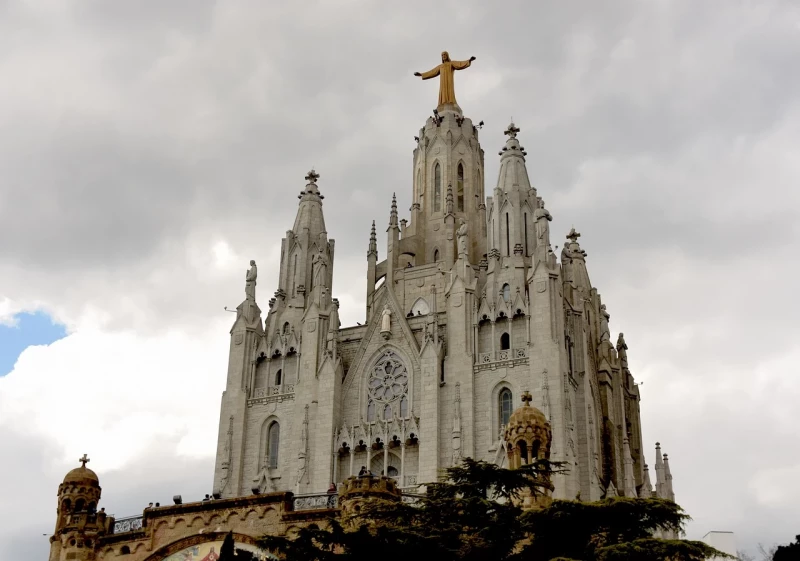
Tibidabo Mountain is one of the main attractions in Barcelona, offering breathtaking views of the city and the Mediterranean coast from its summit. Here are some key points to know about this iconic mountain:
-
Geographical Location: Tibidabo Mountain is situated in the Serra de Collserola, to the west of Barcelona. With an altitude of 512 meters, it is the highest point in this mountain range that surrounds the city.
-
Amusement Park: The summit of Tibidabo Mountain also houses Tibidabo Amusement Park, one of the oldest in Europe. Founded in 1901, the park offers a variety of rides, shows, and activities for visitors of all ages. Among its most iconic attractions are the Ferris wheel, the carousel, and the haunted house.
-
Sagrada Cor Church: Dominating the amusement park, the Sagrada Cor Church is another significant landmark on Tibidabo Mountain. This neo-Gothic church, built between 1902 and 1961, is crowned by a statue of the Sacred Heart of Jesus, visible from afar throughout the city.
-
Panoramic View: Due to its altitude, Tibidabo Mountain provides a spectacular panoramic view of Barcelona, the Mediterranean Sea, and the surrounding area. It's the perfect spot for taking panoramic photos of the city and enjoying the sunset over the coast.
-
Access: Tibidabo Mountain is accessible by car, bus, or funicular railway from downtown Barcelona. The Tibidabo Funicular connects the Vallvidrera Superior metro station to the mountain's summit, offering a picturesque way to reach the amusement park and the Sagrada Cor Church.
Whether it's to enjoy the amusement park attractions, admire the panoramic view, or discover the impressive architecture of the Sagrada Cor Church, Tibidabo Mountain is a must-visit destination for visitors to Barcelona.
 Our tips for getting the most out of your experience.
Our tips for getting the most out of your experience.
If you're planning to visit Tibidabo Mountain during your time in Barcelona, here are some tips to help you make the most of your experience:
-
Plan Your Visit: Check the opening hours of Tibidabo Amusement Park and the Sagrada Cor Church in advance. Plan your visit accordingly to ensure you have enough time to explore both attractions and enjoy the panoramic views.
-
Purchase Tickets in Advance: Consider buying tickets online in advance for Tibidabo Amusement Park to avoid waiting in line at the ticket booths. This can save you time and ensure you have a hassle-free experience.
-
Arrive Early or Late: To avoid crowds, consider visiting Tibidabo Mountain early in the morning or later in the afternoon. This is especially true for Tibidabo Amusement Park, which tends to be less crowded during these times.
-
Take the Funicular: Enjoy a scenic ride on the Tibidabo Funicular, which connects the Vallvidrera Superior metro station to the summit of Tibidabo Mountain. The funicular offers stunning views of Barcelona as it ascends the mountain.
-
Explore the Surrounding Area: After visiting the amusement park and the Sagrada Cor Church, take some time to explore the surrounding area of Tibidabo Mountain. There are hiking trails and viewpoints where you can enjoy even more spectacular views of the city and the Mediterranean Sea.
-
Pack Essentials: Be sure to bring essentials such as sunscreen, water, comfortable walking shoes, and a camera to capture the beautiful scenery.
-
Check for Special Events: Keep an eye out for any special events or performances happening at Tibidabo Amusement Park or the Sagrada Cor Church during your visit. These events can add an extra layer of excitement to your experience.
By following these tips, you'll be well-prepared to enjoy a memorable visit to Tibidabo Mountain and take in its breathtaking views and attractions.
12 - The city's Arab baths
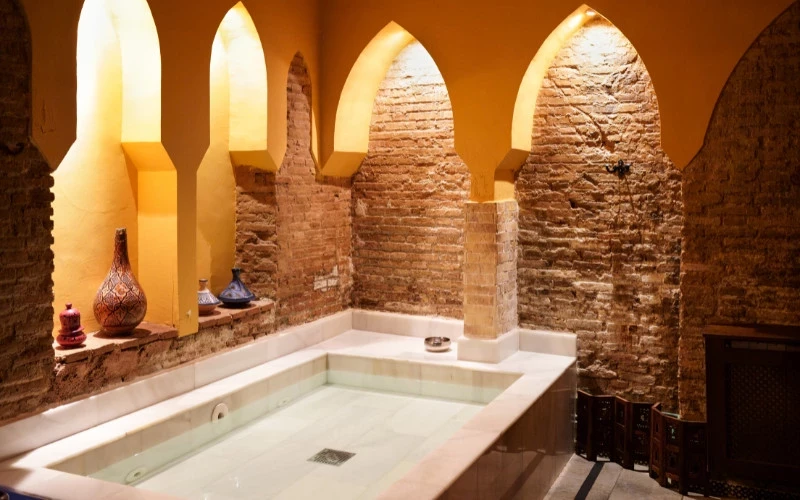
In Barcelona, there aren't historic Arab baths dating back to medieval times like those found in other Spanish cities such as Granada or Cordoba. However, there are modern establishments that offer similar experiences inspired by traditional Arab baths. Here are some of these establishments:
-
Aire de Barcelona: Located in the El Born neighborhood, Aire de Barcelona offers a relaxing space with Arab baths, hammams, and thermal pools. The facilities are designed to recreate the soothing atmosphere of traditional Arab baths.
-
Hammam Al Ándalus: Although Hammam Al Ándalus is more prevalent in southern Spanish cities like Granada and Malaga, it also has a location in Barcelona. Here, you can enjoy an authentic hammam experience with different pools at various temperatures, steam rooms, and massages.
-
Aire de Sant Pau: Another branch of Aire, Aire de Sant Pau, provides a similar experience to Aire de Barcelona. Situated in the Sant Antoni neighborhood, this relaxation oasis offers hammams, hot and cold baths, relaxation rooms, and massages.
These establishments offer visitors the opportunity to relax and rejuvenate in a setting inspired by traditional Arab baths while enjoying a moment of wellness and relaxation.
13 - The Boqueria market
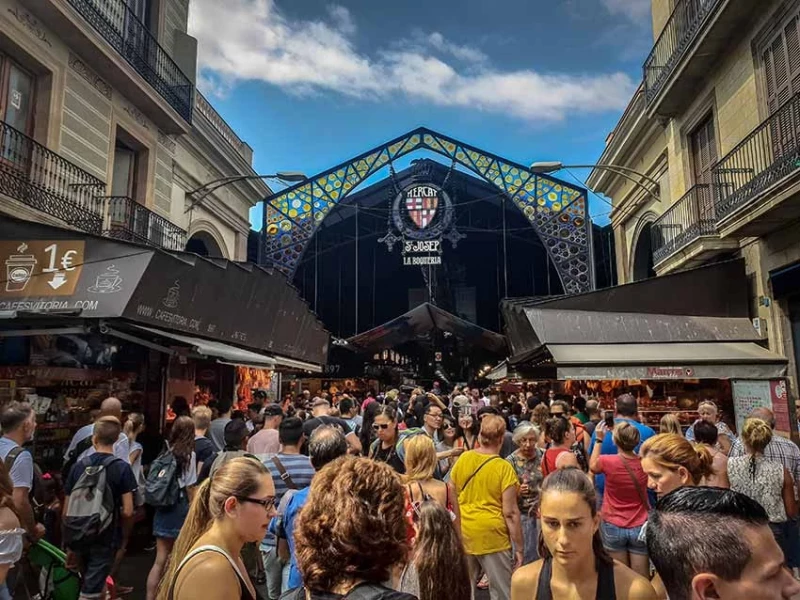
The Boqueria Market, also known as Mercat de Sant Josep de la Boqueria, is one of Barcelona's most iconic markets and a major tourist attraction. Here's some information about this vibrant and colorful market:
-
Location: The Boqueria Market is situated along La Rambla, Barcelona's famous pedestrian avenue, just a short walk from Plaça de Catalunya. Its central location makes it easily accessible for locals and tourists alike.
-
History: The origins of the Boqueria Market date back to the 13th century when it started as a cluster of street vendors selling their goods. Over time, permanent stalls were built, and the market became a must-visit destination for sourcing fresh, local produce.
-
Products: The Boqueria Market offers an incredible variety of fresh produce, including fruits, vegetables, meats, fish, seafood, cheeses, charcuterie, and local products. The stalls are bursting with vibrant colors and enticing aromas, creating a lively and captivating atmosphere.
-
Local Cuisine: In addition to fresh produce, La Boqueria is also home to many tapas bars and food stalls offering delicious local cuisine. It's the perfect place to sample Catalan specialties such as tapas, fresh seafood, and freshly squeezed fruit juices.
-
Ambiance: The Boqueria Market is a bustling and lively place, where locals come to do their daily shopping and tourists flock to experience the vibrant atmosphere and rich culinary heritage of Barcelona. The colorful stalls, enthusiastic vendors, and tantalizing smells make La Boqueria an unforgettable sensory experience.
In summary, the Boqueria Market is more than just a market - it's a symbol of Barcelona's soul and culture, where visitors can discover a wide variety of delicious local products while immersing themselves in the lively atmosphere of this iconic venue.
14 - Ciutadella Park
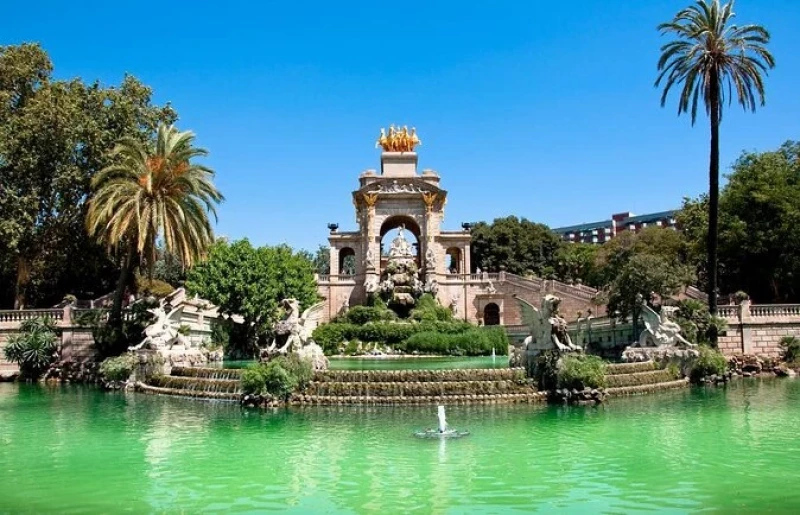
The Ciutadella Park is one of Barcelona's most popular public parks, offering a relaxing escape from the bustling city streets. Here's some information about this beautiful park:
-
Location: Situated in the Ciutat Vella district of Barcelona, the Ciutadella Park covers an area of approximately 70 acres (28 hectares). It is located near the Old Town, just northeast of the Barri Gòtic (Gothic Quarter).
-
History: The park's name, Ciutadella, originates from the military citadel that once stood on the site. Constructed in the 18th century, the citadel was later demolished, and the area was transformed into a public park in the 19th century. Today, it is one of the city's largest green spaces.
-
Features: The Ciutadella Park boasts a wide range of attractions and amenities. These include lush gardens, ponds, sculptures, playgrounds, and walking paths. The park's centerpiece is the stunning Cascada (Waterfall), a monumental fountain designed by Josep Fontserè with the help of a young Antoni Gaudí.
-
Arc de Triomf: The main entrance to the Ciutadella Park is through the Arc de Triomf, a triumphal arch built for the 1888 Barcelona World Fair. This grand arch serves as a gateway to the park and is a popular landmark in its own right.
-
Activities: The park offers various activities for visitors to enjoy, such as picnicking, jogging, cycling, rowing on the lake, or simply relaxing amidst nature. It's also a favorite spot for locals to gather for outdoor concerts, cultural events, and leisurely strolls.
-
Attractions: In addition to the Cascada and the Arc de Triomf, other notable attractions within the Ciutadella Park include the Zoological Museum, the Parliament of Catalonia building, and the Umbracle, a shaded walkway with tropical plants.
Overall, the Ciutadella Park is a tranquil oasis in the heart of Barcelona, providing both locals and tourists with a peaceful retreat and plenty of opportunities for outdoor recreation and exploration.
 Our tips for getting the most out of your experience.
Our tips for getting the most out of your experience.
If you're planning to visit Ciutadella Park during your stay in Barcelona, here are some tips to enhance your experience:
-
Choose the right time: The park can get quite crowded, especially on weekends and sunny days. To avoid the crowds, consider visiting in the early morning on weekdays.
-
Bring water and snacks: If you plan to spend some time in the park, bring along bottled water and snacks. It's a great spot for a picnic, especially near the Cascada or the lake.
-
Explore on foot or by bike: The park is quite large, so exploring on foot can be enjoyable. Alternatively, you can rent a bike for a quicker way to get around and cover more ground.
-
Visit the main attractions: Don't miss the Cascada, Arc de Triomf, Zoological Museum, and other points of interest in the park. Take the time to explore them and admire their architectural and natural beauty.
-
Relax by the lake: The park's lake offers a picturesque setting to relax and enjoy the view. You can rent a rowboat and paddle around the lake for a tranquil experience.
-
Attend events: Check the local event calendar to see if there are any concerts, street performances, or other special activities scheduled in the park during your visit.
-
Respect the environment: Like any public space, please respect the environment by not leaving behind any trash and following the park rules, such as not walking on the grass or feeding the animals.
By following these tips, you'll be able to make the most of your visit to Ciutadella Park and have a wonderful time exploring this green oasis in the heart of Barcelona.
15 - Attend a flamenco show
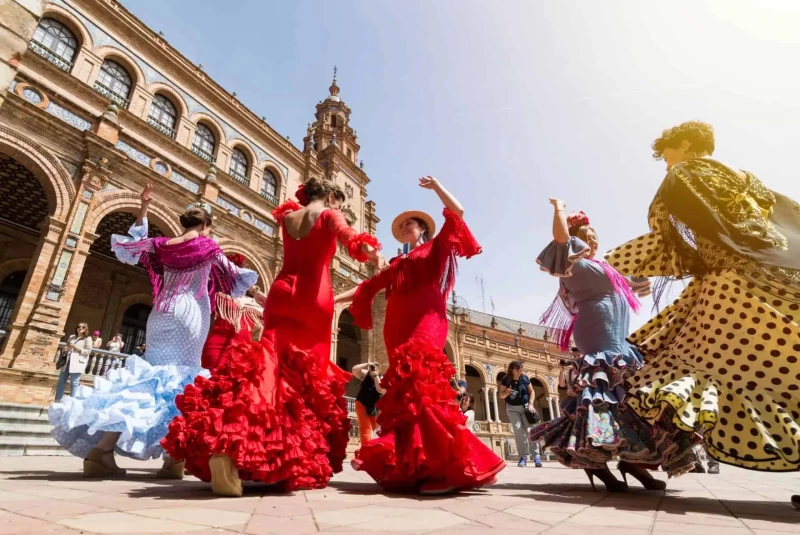
Attending a flamenco show in Barcelona is an unforgettable experience for many visitors. Here are some tips to make the most of your flamenco experience:
-
Choose a reputable venue: Barcelona offers numerous places where you can see flamenco shows. Opt for well-established venues such as traditional tablaos flamencos or reputable theaters.
-
Book in advance: Flamenco shows in Barcelona are often in high demand, especially during the peak tourist season. Be sure to book your tickets in advance to secure your spot, especially if you have a specific show in mind.
-
Be prepared to pay the price: Flamenco shows in Barcelona can be a bit pricey, especially at renowned venues. Check prices in advance and include this in your travel budget.
-
Prepare to be moved: Flamenco is a passionate and emotional art form. Expect to be moved by the music, dance, and intense expression of the performers.
-
Choose a show with dinner: Many tablaos flamencos offer dinner packages where you can enjoy a traditional Spanish meal while watching the show. It's a great opportunity to combine food, culture, and entertainment into one experience.
-
Be respectful: During the show, make sure to respect the performers by avoiding excessive talking or noise. This allows everyone to fully enjoy the experience.
By following these tips, you'll be ready to have an unforgettable experience attending a flamenco show in Barcelona. Enjoy the passion, energy, and beauty of this traditional Spanish art form.
16 - Nightlife in Barcelona
La vie nocturne à Barcelone est dynamique et diversifiée, offrant quelque chose pour tous les goûts et tous les styles. Voici un aperçu des principales caractéristiques de la vie nocturne à Barcelone :
-
Bars et pubs: Barcelone regorge de bars et de pubs où vous pouvez savourer des boissons locales et internationales dans une atmosphère décontractée. Des quartiers comme El Born, Gràcia et le Barri Gòtic regorgent de bars animés où vous pourrez déguster des boissons et profiter de l'ambiance.
-
Terrasses en plein air: Avec son climat méditerranéen agréable, Barcelone offre de nombreuses terrasses en plein air où vous pouvez siroter des cocktails tout en profitant de la douce brise et des vues sur la ville. Les terrasses sur les toits sont particulièrement populaires et offrent souvent une vue imprenable sur la ville et la mer.
-
Clubs et discothèques: Pour les amateurs de musique et de danse, Barcelone propose une variété de clubs et de discothèques qui restent ouverts jusqu'aux premières heures du matin. Des endroits comme Poble Espanyol, Port Olímpic et la zone du Poble-sec sont connus pour leur vie nocturne animée.
-
Festivals et événements: Barcelone accueille également de nombreux festivals et événements tout au long de l'année, notamment des concerts en plein air, des soirées thématiques, des événements culturels et des fêtes de quartier. Consultez les calendriers d'événements locaux pour découvrir ce qui se passe pendant votre séjour.
-
Bars à tapas et restaurants tardifs: Pour ceux qui préfèrent une soirée plus détendue, de nombreux bars à tapas et restaurants restent ouverts tard dans la nuit, offrant une délicieuse cuisine locale et internationale jusqu'aux petites heures du matin.
-
Promenades nocturnes: Enfin, une autre façon de profiter de la vie nocturne à Barcelone est de simplement se promener dans les rues animées de la ville. Les rues comme La Rambla et les quartiers comme El Raval prennent vie la nuit, offrant une atmosphère animée et colorée.
Quelle que soit votre préférence en matière de vie nocturne, vous trouverez certainement quelque chose pour vous divertir à Barcelone. Assurez-vous simplement de respecter les règles locales et de profiter de votre soirée en toute sécurité!
 Our tips for getting the most out of your experience.
Our tips for getting the most out of your experience.
If you're looking to enjoy the nightlife in Barcelona, here are some tips for a successful experience:
-
Do your research: Explore the different neighborhoods of Barcelona to find the one that best suits your nightlife preferences. Each neighborhood has its own charm and offers a distinct atmosphere.
-
Plan your itinerary: Check the opening hours of bars, clubs, and events you want to attend. Also, make sure you're aware of transportation options to get home safely after a night of entertainment.
-
Relax and soak up the atmosphere: Nightlife in Barcelona is often laid-back and lively. Take the time to immerse yourself in the atmosphere and socialize with locals and fellow visitors.
-
Avoid tourist traps: While some tourist spots may offer a pleasant experience, it's often best to explore bars and clubs less frequented by tourists for a more authentic experience.
-
Stay safe: Like in any major city, it's important to remain vigilant and use common sense when going out at night. Make sure to keep an eye on your belongings and avoid venturing alone into poorly lit or sparsely populated areas.
-
Respect local rules: Be sure to adhere to local rules and customs regarding behavior in bars and clubs. This may include practices such as tipping, respecting queues, and avoiding loud or inappropriate behavior.
By following these tips, you'll be able to fully enjoy Barcelona's vibrant and diverse nightlife while ensuring a pleasant and safe experience.
17 - Taste Catalan cuisine
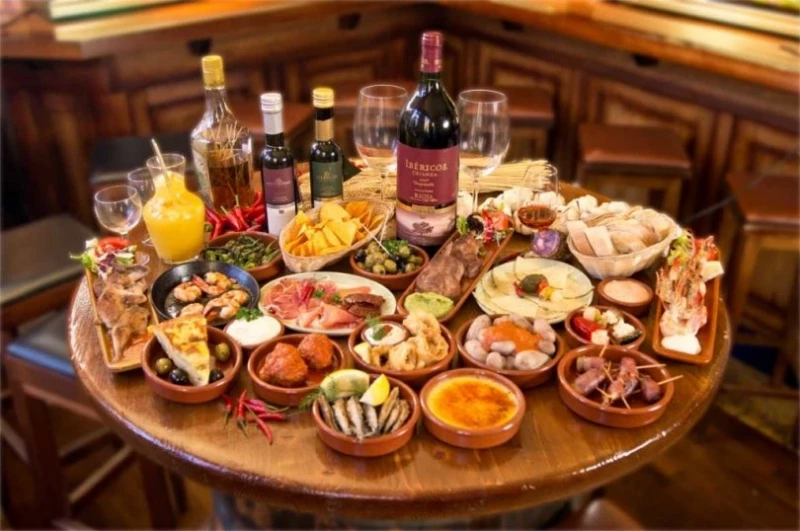
Catalan cuisine is rich in flavors, with a strong Mediterranean influence and fresh local ingredients. Here's an overview of the characteristics of Catalan cuisine:
-
Seafood: Due to its proximity to the Mediterranean Sea, Catalan cuisine highlights a variety of fresh seafood and fish. Dishes such as paella, fideuà (a paella-like dish with noodles), and grilled seafood are staples of Catalan cuisine.
-
Charcuterie: Catalan charcuterie is also renowned, with specialties such as Iberian ham, fuet (a dry-cured sausage), and butifarra (a Catalan sausage). These savory delights are often served as appetizers or in main dishes.
-
Traditional dishes: Catalan cuisine boasts many traditional dishes that reflect the region's history and culture. Among the most popular dishes are escalivada (grilled vegetables), bacalao a la llauna (oven-baked cod with garlic and olive oil), and romesco (a sauce made from nuts, almonds, and peppers).
-
Local ingredients: Catalan cuisine emphasizes the use of local and seasonal ingredients. Barcelona's markets, such as La Boqueria, offer an abundance of fresh produce, from colorful fruits and vegetables to cheeses and aromatic spices.
-
Desserts and pastries: Catalan desserts are also delightful, with specialties such as churros (fried doughnuts served with hot chocolate), crema catalana (a vanilla-flavored crème brûlée), and panellets (small almond cakes traditionally consumed during All Saints' Day).
-
Wines and beverages: Catalonia is also famous for its wines, with several renowned wine regions such as Penedès and Priorat. Catalan wines, including cavas (sparkling wines), are often served with meals to complement the dishes.
Overall, Catalan cuisine is a celebration of the richness of local produce and culinary tradition of the region. Whether you're a seafood lover, a meat enthusiast, or a vegetarian, you'll certainly find something to savor in Catalan cuisine.
 Our tips for getting the most out of your experience.
Our tips for getting the most out of your experience.
If you're looking to savor Catalan cuisine during your visit to Barcelona or Catalonia, here are some tips for an enjoyable experience:
-
Try traditional Catalan dishes: Explore the local cuisine by sampling traditional dishes such as paella, calcots with romesco sauce, esqueixada (salted cod salad), or botifarra amb mongetes (sausage with beans). These dishes offer a taste of authentic Catalan flavors.
-
Visit local markets: Head to one of Barcelona's vibrant markets, such as La Boqueria or Mercat de Santa Caterina, to discover fresh, local ingredients. Take the opportunity to chat with vendors and learn about Catalan products like cheeses, olives, cured meats, and seasonal fruits.
-
Dine at traditional restaurants: Seek out traditional Catalan restaurants (called "bodegas" or "fondes") that offer regional specialties prepared with care and authenticity. Look for establishments with a local clientele, as this often indicates quality and authenticity.
-
Pair with local wines: Catalonia is known for its excellent wines, so be sure to pair your Catalan dishes with local wines. Ask for recommendations from the restaurant staff or explore the wine regions of Penedès, Priorat, or Empordà to taste and learn about Catalan wines.
-
Try small plates: Embrace the tradition of tapas or "pica-pica" (small plates) by ordering a variety of dishes to share with your dining companions. This allows you to sample a wider range of Catalan flavors and specialties in one meal.
-
Attend food festivals: If your visit coincides with a local food festival or gastronomic event, take advantage of the opportunity to taste a variety of Catalan dishes and specialties in one place. These events often showcase the best of Catalan cuisine and culinary traditions.
-
Learn about Catalan cuisine: Take a cooking class or food tour to gain a deeper understanding of Catalan cuisine, its history, and its ingredients. Participating in a hands-on cooking experience can enhance your appreciation for Catalan culinary traditions.
By following these tips, you'll be able to fully immerse yourself in the rich and diverse flavors of Catalan cuisine and enjoy a memorable culinary experience in Barcelona or Catalonia.
18 - Take a day trip to Montserrat
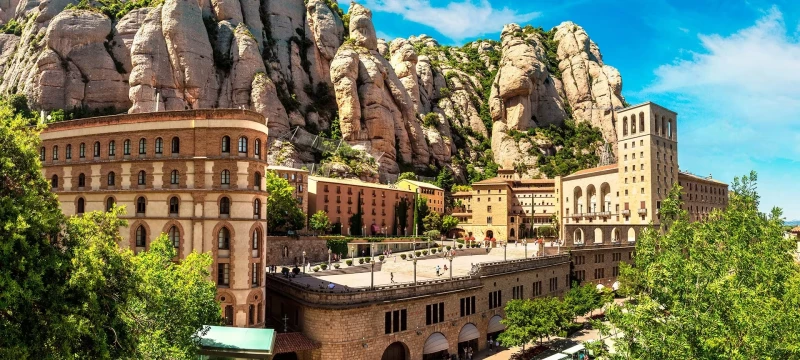
A day trip from Barcelona to Montserrat is an unforgettable experience. Here's a guide to help you plan your excursion:
-
Transportation: There are several transportation options available to get to Montserrat from Barcelona. You can take a train from Plaça d'Espanya station to Montserrat-Aeri station, then ride the funicular or cable car up to the monastery. Alternatively, you can book a guided bus tour that includes transportation from your accommodation in Barcelona.
-
Travel Time: The train journey from Barcelona to Montserrat takes about an hour. Plan for a full day for your excursion, as you'll want to explore the monastery, hike the surrounding trails, and perhaps even hike to the summit of the mountain for panoramic views.
-
Montserrat Monastery: Once you arrive at Montserrat, visit the Benedictine monastery, which is an important pilgrimage site in Catalonia due to its statue of the Black Madonna, the Virgen de Montserrat. Explore the church and museum, and possibly attend a mass or choir performance if you can.
-
Hiking: Montserrat also offers beautiful hiking trails through its spectacular rock formations. You can choose from a variety of trails suitable for different skill levels and durations. Be sure to bring water, snacks, and comfortable hiking shoes.
-
Panoramic Views: If weather permits, consider hiking to the summit of the mountain to enjoy stunning views of the surrounding area. The Sant Joan funicular takes you to the top in just a few minutes, where you can admire the breathtaking views of the mountains and sea.
-
Sampling Local Cuisine: Take the opportunity to sample Catalan cuisine at one of the restaurants or tapas bars in Montserrat. Don't miss the chance to taste the locally produced Montserrat cheese.
-
Timings: Make sure to check the train schedules for return trips to Barcelona and plan accordingly so you don't miss your transportation back.
By following these tips, you'll be able to fully enjoy your day trip from Barcelona to Montserrat and discover the natural and spiritual beauty of this iconic destination in Catalonia.
Barcelona - Where to Stay?
In Barcelona, there's a wide variety of neighborhoods where you can stay, each offering a different vibe and catering to different accommodation needs. Here are some of the most popular neighborhoods to stay in Barcelona:
-
Eixample: This district is famous for its modernist architecture, including the works of Antoni Gaudí. It's also well-connected by public transportation and filled with restaurants, shops, and bars. It's an excellent choice if you want to be close to the main tourist attractions.
-
Gothic Quarter (Barri Gòtic): Located in the heart of the old town, the Gothic Quarter is full of picturesque medieval streets, lively squares, and historic sites. It's the perfect place if you're looking for an authentic atmosphere and want to be close to cultural attractions.
-
El Born: Adjacent to the Gothic Quarter, El Born is a trendy neighborhood with many tapas bars, designer shops, and art galleries. It also offers easy access to the beaches and Ciutadella Park.
-
Gràcia: This bohemian and lively district has a village-like atmosphere with shady squares, pedestrian streets, and small cafes. It's less touristy than other neighborhoods in Barcelona and offers an authentic local atmosphere.
-
Barceloneta: If you want to be close to the beach, Barceloneta is the perfect choice. This lively neighborhood is filled with seafood restaurants, beach bars, and offers easy access to the Mediterranean Sea.
-
Poblenou: Located to the east of the city, Poblenou is an up-and-coming neighborhood with a modern and creative vibe. It offers a quieter, less touristy alternative to the city center while still being well-connected to major attractions.
Whether you're looking for a historic, trendy, beachside, or local atmosphere, Barcelona offers a multitude of accommodation options in its various neighborhoods to suit all tastes and budgets.
Barcelona - How to get around?
To get around and explore Barcelona, you have several transportation options that make navigating the city easy and convenient:
-
Metro: Barcelona's metro system is fast, efficient, and extensive, covering a large portion of the city. It consists of multiple lines that serve key neighborhoods and major tourist attractions. Stations are well-marked and easy to navigate.
-
Bus: Barcelona has an extensive bus network that not only covers the city but also extends to the surrounding areas. Buses are a good option if you want to reach neighborhoods not accessible by metro. You can purchase tickets on board the bus or use a TMB (Transports Metropolitans de Barcelona) card to pay for your journey.
-
Tram: The tram is a convenient option for getting around certain parts of the city, particularly along the coastline. It also serves neighborhoods like Diagonal Mar and Poblenou.
-
Biking: Barcelona is very bike-friendly, with numerous bike lanes and a public bike rental system called Bicing. You can also rent bikes from many private bike rental shops to explore the city at your own pace.
-
Taxi and Ride-Hailing: Taxis are readily available throughout the city and offer a convenient option for transportation, especially at night or if you need direct transport to a specific destination. Additionally, ride-hailing services like Uber and Cabify are also available in Barcelona.
-
Walking: Barcelona is a very walkable city, especially in historic neighborhoods like the Gothic Quarter and El Born. Walking allows you to admire the architecture, discover hidden gems, and soak in the lively atmosphere of the city.
By utilizing these different transportation modes, you'll be able to easily explore the many treasures Barcelona has to offer, whether it's its iconic landmarks, vibrant neighborhoods, or sun-soaked beaches.
Barcelona - Best period
The best time to visit Barcelona depends on your preferences regarding weather, crowds, and events. Here's a breakdown of the different seasons:
-
Spring (March to May): Spring is a fantastic time to visit Barcelona. The weather starts to warm up, with mild temperatures and fewer crowds compared to the peak summer months. It's a great time for sightseeing, outdoor activities, and enjoying the city's parks and outdoor cafes.
-
Summer (June to August): Summer is the high tourist season in Barcelona, with warm temperatures and plenty of sunshine. The city is bustling with visitors, and popular attractions can get crowded. It's perfect for beachgoers and those looking to experience the vibrant atmosphere of festivals and outdoor events.
-
Fall (September to November): Fall is another excellent time to visit Barcelona, with pleasant temperatures and fewer tourists compared to summer. The city hosts various cultural events and festivals during this time, and you can still enjoy outdoor activities comfortably.
-
Winter (December to February): Winter in Barcelona is relatively mild compared to other European cities, but it can still be chilly and rainy at times. However, the city is less crowded, and you can find better deals on accommodations and attractions. Winter is an excellent time to explore museums, galleries, and indoor attractions, and you might even catch some festive holiday markets and events.
Ultimately, the best time to visit Barcelona depends on your preferences. If you prefer warm weather and don't mind crowds, summer might be ideal for you. However, if you prefer milder temperatures and fewer tourists, spring and fall are excellent alternatives.



